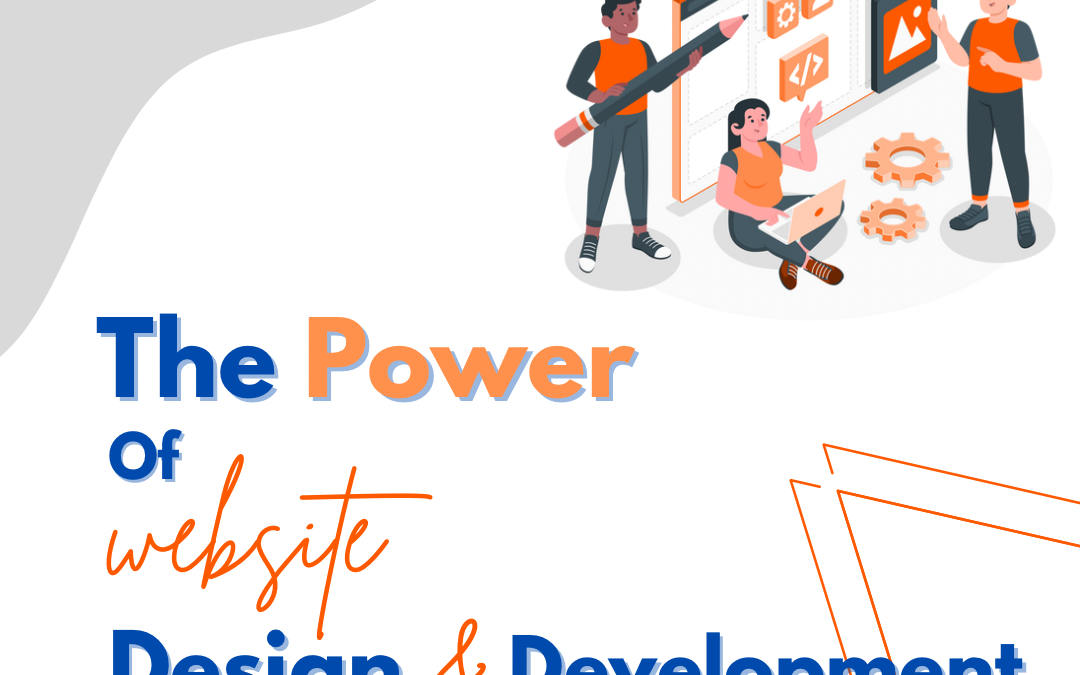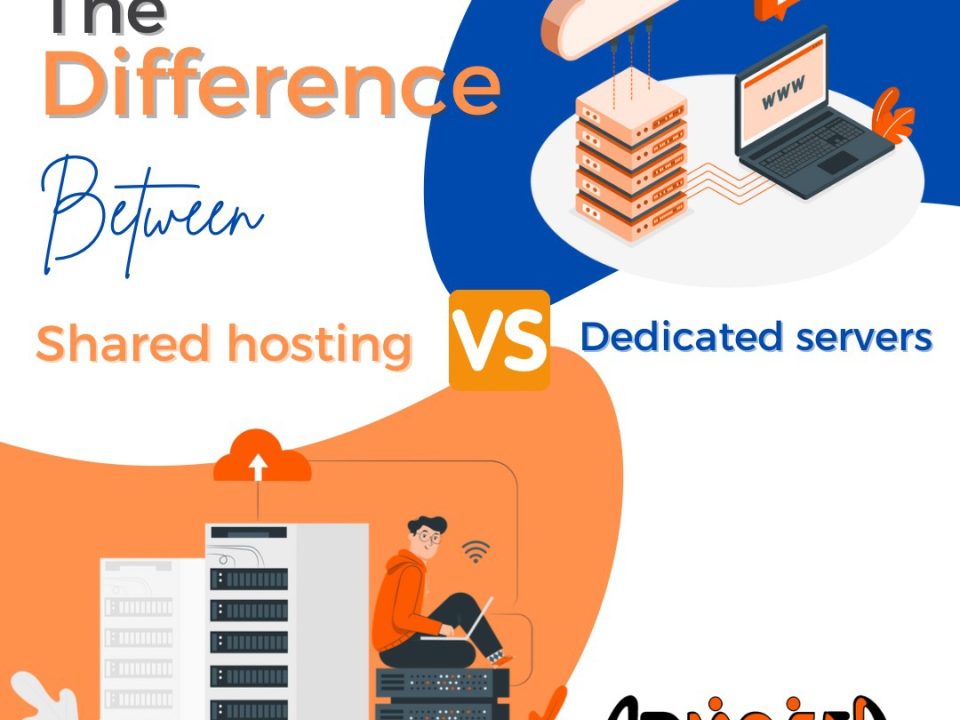New Approaches in Digital Marketing
December 24, 2023
Shared Hosting VS Servers
February 2, 2024The Power of Website Design and Web Development
In today’s digital landscape, having a well-designed and fully functional website is crucial for businesses of all sizes. A website serves as the online face of a company, representing its brand, products, and services to a vast audience. It is the gateway for potential customers to learn about a business, make purchases, and engage with its offerings. In this article, we will explore the significance of website design and web development in creating a strong online presence, attracting customers, and driving business growth.
1. The Role of Website Design and Web Development
Website design and web development are two interconnected processes that form the foundation of a successful online presence. While website design focuses on the visual elements and user interface of a website, web development encompasses the technical aspects and functionality. Together, they create a seamless user experience and convey the brand’s message effectively.
1.1 Website Design: Creating an Engaging User Experience
Website design plays a crucial role in attracting and engaging visitors. A well-designed website captivates users with visually appealing layouts, intuitive navigation, and compelling content. It creates a positive first impression, instilling trust and confidence in the brand. A user-friendly interface ensures that visitors can easily find the information they seek, leading to higher conversion rates and customer satisfaction.
1.2 Web Development: Building Functionality and Performance
Web development focuses on the behind-the-scenes aspects of a website, ensuring its functionality and performance. It involves coding, database management, server configuration, and other technical tasks. Web developers work hand in hand with designers to bring the visual elements to life and create a seamless user experience. They optimize the website for speed, responsiveness, and search engine visibility, contributing to its overall success.
2. Benefits of Effective Website Design and Web Development
Investing in effective website design and web development offers numerous benefits for businesses. Let’s delve into some of the key advantages these processes bring:
2.1 Enhanced User Experience
A well-designed and developed website provides a seamless user experience, making it easy for visitors to navigate, interact with, and understand the content. Intuitive navigation, clear calls-to-action, and responsive design ensure that users can access information effortlessly, leading to increased engagement and conversions.
2.2 Improved Brand Perception and Trust
A professionally designed website with a visually appealing layout and high-quality content creates a positive brand perception. It instills trust in potential customers, signaling that the business is credible, reliable, and committed to providing a great user experience. A well-designed website reflects the brand’s values, mission, and unique selling propositions, helping it stand out from competitors.
2.3 Increased Online Visibility and Reach
Effective website design and web development contribute to improved search engine optimization (SEO), increasing a website’s visibility in search engine results pages (SERPs). Optimized code, proper tagging, and relevant content help search engines understand and index the website better. As a result, the website appears higher in search rankings, attracting more organic traffic and expanding the brand’s reach.
2.4 Competitive Advantage
In today’s digital age, having a well-designed website is no longer a luxury but a necessity. A professionally designed and developed website gives businesses a competitive edge. It sets them apart from competitors with outdated or poorly functioning websites, positioning them as industry leaders dedicated to providing a superior online experience.
2.5 Increased Conversion Rates and Sales
An effective website design and web development strategy can significantly impact conversion rates and sales. A user-friendly interface, clear product information, and streamlined purchasing processes make it easy for customers to make informed decisions and complete transactions. A well-designed website instills confidence in potential customers, leading to increased conversions and sales.
3. The Web Development Process
Building a fully-functional website involves a comprehensive web development process. While the exact steps may vary depending on the project’s complexity, the following are the fundamental stages typically involved:
3.1 Information Gathering
The first step in web development is gathering all the necessary information about the project. This includes understanding the client’s needs, identifying the website’s goals, and researching the target audience. Web developers work closely with clients to gather requirements, create user personas, and define the website’s main features and functionalities.
3.2 Planning and Site Mapping
Based on the gathered information, web developers create a detailed action plan and design a site map. The site map outlines the main sections and pages of the website, providing a clear structure for the development process. Planning also includes defining the website’s visual elements, such as typography, color schemes, and imagery, to ensure consistency and branding.
3.3 Design and Prototyping
During the design phase, web developers transform the planned structure into visual elements. They create wireframes, mockups, and prototypes to visualize the website’s layout, user interface, and interaction flow. This stage involves collaboration between designers and developers to ensure a seamless integration of design and functionality.
3.4 Development and Coding
Once the design and prototyping are finalized, web developers start coding the website. They use programming languages such as HTML, CSS, JavaScript, and frameworks like React, Angular, or Vue.js. Backend developers handle server-side tasks, managing databases, and integrating necessary functionalities. Full-stack developers are proficient in both front-end and back-end development, allowing them to handle all aspects of the project.
3.5 Testing and Quality Assurance
Testing is a critical phase in web development to ensure the website functions as intended. Developers thoroughly test the website for compatibility, responsiveness, functionality, and performance. They identify and fix any bugs or issues to provide a seamless user experience across different devices and browsers. Testing also includes validating the code to adhere to web standards and ensuring proper security measures are in place.
3.6 Launch and Maintenance
Once the website has passed all tests and received final approval, it is ready for launch. Developers deploy the website to the live server, ensuring all files and databases are correctly transferred. Before the official launch, a final run-through is conducted to verify that the website is fully functional and optimized. Once live, developers monitor the website, perform regular maintenance, and address any issues that arise.
4. Learning Resources for Web Development
For those interested in learning web development, numerous online resources are available. These resources offer comprehensive courses, tutorials, and communities to help individuals acquire the necessary skills and stay updated with the latest trends. Here are some popular platforms and communities to explore:
- Udemy
- Coursera
- freeCodeCamp
- Stack Overflow
- Treehouse
- A List Apart
- CSS-Tricks
- JavaScript Weekly
Joining online communities and forums is also valuable for learning web development. These platforms provide opportunities to connect with like-minded individuals, seek guidance from mentors, and access exclusive resources. Learning web development opens doors to lucrative career opportunities or the ability to create and manage your own web projects.
5. Types of Web Apps
Web apps have evolved significantly from static websites to dynamic and responsive applications. Businesses now have various options to choose from based on their specific needs and target audience. Let’s explore some common types of web apps:
5.1 Static Web Apps
Static web apps consist of fixed, pre-rendered pages with hardcoded content and structure. Each user sees the same content, regardless of their location or device. While static web apps are relatively simple and cost-effective to create, they may not provide the best user experience, particularly for mobile users.
5.2 Dynamic Web Apps
Dynamic web apps offer personalized content based on user preferences and data stored in the website’s database. These apps provide a more interactive experience, allowing users to receive relevant recommendations, offers, and suggestions. Dynamic web apps are easier to update, as changes can be made directly to the database without modifying the code.
5.3 Hybrid Web Apps
Hybrid web apps combine static and dynamic elements to create a unified design across different devices and platforms. These apps leverage the benefits of both static and dynamic web apps, offering a seamless user experience on desktop and mobile devices.
5.4 Mobile Web Apps
Mobile web apps are specifically designed for optimal performance on mobile devices. They adapt to different screen sizes and prioritize fast loading times. Mobile web apps often simplify the content and navigation to cater to the limitations of mobile devices, providing a smooth user experience.
5.5 Responsive Web Apps
Responsive web apps are designed to adapt to various screen sizes, from desktops to smartphones. They use flexible layouts and responsive design techniques to ensure the content is displayed appropriately on different devices. Responsive web apps provide a consistent user experience and eliminate the need for separate mobile and desktop versions of the website.
5.6 Custom Web Apps
Custom web apps are tailor-made for a specific brand, product, or company. They are designed to meet unique requirements and cater to a specific target audience. Custom web apps offer full control over the design, functionality, and features, allowing businesses to create a distinctive online presence.
6. Choosing a Web Development Partner
While some businesses may have the resources and expertise to develop their own web apps, partnering with a professional web development company offers numerous advantages. Here are some benefits of hiring a web development partner:
6.1 Focus on Core Business Activities
By outsourcing web development, businesses can focus on their core activities, such as product development, customer service, and marketing. Web development companies handle the technical aspects, ensuring the website is professionally designed, developed, and maintained. This allows businesses to allocate their resources more effectively.
6.2 Expertise and Knowledge
Web development companies bring a wealth of expertise and knowledge to the table. They stay updated with the latest technologies and industry trends, ensuring that the web app is built using best practices. Web development professionals have the skills to optimize the website for speed, performance, security, and search engine visibility, enhancing the overall user experience.
6.3 Cost and Time Efficiency
Outsourcing web development can be a cost-effective solution, especially for businesses without in-house development teams. Developing a web app from scratch requires significant time and resources. By partnering with a web development company, businesses can save time and reduce costs by leveraging the expertise of professionals who can complete the project efficiently.
6.4 Technical Support and Maintenance
Web development companies provide ongoing technical support and maintenance for the web app. They monitor the website for any issues, perform regular updates, and address bugs or security vulnerabilities. This ensures that the web app remains secure, up-to-date, and functioning optimally, providing a seamless user experience.
7. The Impact of Effective Website Design and Web Development
The impact of effective website design and web development on businesses cannot be overstated. An optimized and well-designed website enhances the user experience, builds brand credibility, and drives conversions. It expands the reach of the business, attracts a wider audience, and improves online visibility. With the right web development partner, businesses can unlock the full potential of their online presence and achieve long-term success.
In conclusion, investing in website design and web development is crucial for businesses in the digital age. It empowers businesses to create engaging user experiences, build brand trust, increase online visibility, drive conversions, and gain a competitive edge. Whether it’s a static web app, dynamic web app, or custom web app, businesses can leverage the power of effective web development to achieve their goals and establish a strong online presence. By partnering with a professional web development company, businesses can ensure that their website is designed, developed, and maintained to the highest standards, providing a seamless user experience and driving business growth.
Remember, your website is the digital face of your business. Make it count!



